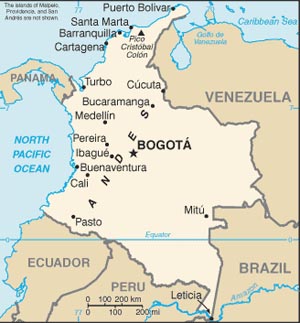3.2: Sección 1 - Colombia
- Page ID
- 153946
Colombia
Datos importantes:
La capital: Bogotá D.C.
La ubicación: Está en la región noroccidental de América del Sur.
La lengua: El español (y otras lenguas indígenas).
La moneda: El peso.
El clima: hay dos estaciones principalmente: la estación seca y la estación lluviosa.
Mapas:
|
Map of Colombia. Author: Mike Vondran (licensed under CC By 2.0) |
Mapa de América de Sur by Douglas Fernandes (lincensed under CC By 2.0) |
Figuras importantes
Colombia produjo dos figuras sobresalientes de la cultura mundial: el escritor Gabriel García Márquez y el artista Fernando Botero.
|
Gabriel García Márquez by Jose Lara (licensed under CC BY-SA 2.0) |
Fernando Botero by Etolane (Licensed under CC BY-NC-ND 2.0) |
Gabriel García Márquez empezó su carrera como periodista, pero luego pasó a escribir cuentos, novelas y guiones cinemáticos. Su obra más famosa es Cien años de soledad (1967) que tiene un estilo novedoso llamado el “realismo mágico”. García Márquez nos dio otros personajes inolvidables (unforgettable) en sus cuentos cortos como “La increíble y triste historia de la cándida Eréndira y de su abuela desalmada” (1972) y “Un señor muy viejo con alas enormes” (1955). Por todas estas obras, se dice que es el segundo escritor más importante de la lengua española (después de Cervantes).
Las pinturas y esculturas de Fernando Botero tienen un estilo inmediatamente reconocible, con figuras “gorditas” (chubby) que simultáneamente comunican una visión humorística y crítica de la realidad. Botero vive mayormente en París, pero visita a Colombia con frecuencia. Tiene esculturas instaladas en muchas ciudades por el mundo y una serie de pinturas protestando el tratamiento de los prisioneros en Abu Ghraib, Irak, (2007) que fue internacionalmente renombrada, pero Botero también trata con temas más íntimos como la religión y la maternidad.
La industria esmeraldera
Las esmeraldas de Colombia son las más cotizadas (valued) del mercado por su particular composición química. Sin embargo, a pesar del aumento en su valor (un 4%) en los últimos años, la cantidad de exportaciones a destinos como India, China, EE.UU. y Europa bajan, siendo Brasil y Zambia los líderes en materia de producción. La escasez (shortage) de producción se debe a que la extracción requiere una gran inversión de capital. Cada vez es necesario cavar (dig) más y las esmeraldas son un producto no renovable difícil de hallar.

Colombian emerald. Author: Géry Parent (shared by CC BY-ND 2.0)
¿Qué entendiste?
Contesta a las siguientes preguntas (escribe en tu cuaderno):
1. ¿Qué trabajo tenía Gabriel García Márquez antes de ser escritor?
2. ¿Cómo se llama el estilo que García Márquez usa en sus obras?
3. ¿Qué ilustra Fernando Botero en sus obras?
4. ¿Por qué Colombia no es un líder en materia de producción de esmeraldas hoy en día?
- Answer
-
1. García Márquez empezó como escritor.
2. Se llama el 'realismo mágico'.
3. Ilustra una visión humorística y crítica de la realidad.
4. Porque la industria necesita una gran inversión de capital y las esmeraldas son difíciles de encontrar.
Francia Márquez
Francia Márquez es vicepresidenta de Colombia desdel el 7 de agosto de 2022. Mira el siguiente video y contesta a las perguntas de comprensión. Do not worry about not understanding every single word. Try to hear key information and look for visuals (what you see in the video, titles, etc.) to help you out.
¿Qué entendiste?
1. ¿Por qué Francia Márquez es una figura importante de Colombia?
2. ¿Qué ropa lleva ella en general? Piensa en el estilo, colores, etc.
3. En su discurso, ella menciona a una figura importante de EE.UU. ¿A quién menciona?
4. ¿Cómo celebran sus simpatizantes (supporters)?
- Answer
-
1. Porque es la primera vicepresidenta afrocolombiana en la historia del país.
2. La ropa tiene estilo tradicional africano y lleva muchos colores (amarillo, verde, etc.)
3. Ella menciona a Martin Luther King Jr.
4. Con música y gritando 'sí se puede'.
Contributors and Attributions
CC licensed content, Original
- Adapted from Civilizacion hispanoamericana. Authored by: Elizabeth Small. Provided by: SUNY Oneonta. Located at: https://courses.lumenlearning.com/suny-oneonta-latinamericanciv. License: CC BY-NC-SA: Attribution-NonCommercial-ShareAlike /
- Adapted from Acceso from the University of Kansas: https://acceso.ku.edu/unidad6/almana...eraldera.shtml
- Images changed/added and some wording modified from original sources.
- New video and wording added.






